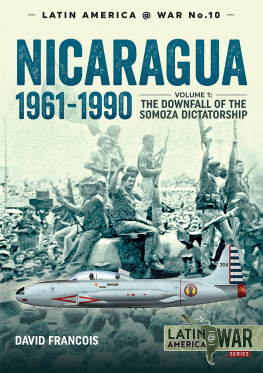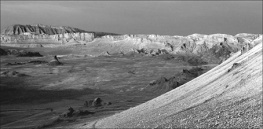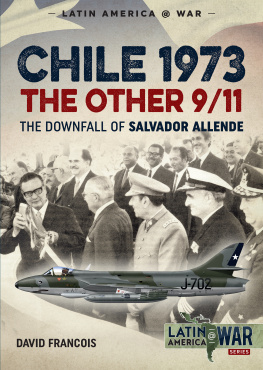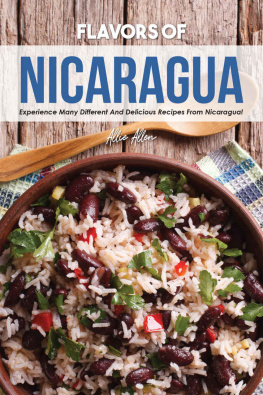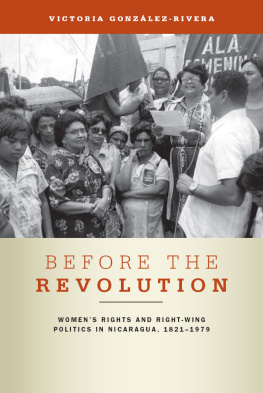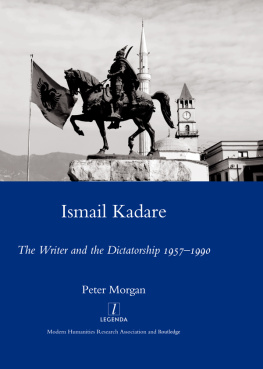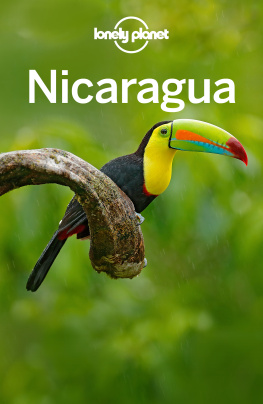Nicaragua, 1961-1990. Volume 1
Helion & Company Limited
Unit 8 Amherst Business Centre
Budbrooke Road
Warwick
CV34 5WE
England
Tel. 01926 499 619
Fax 0121 711 4075
Email:
Website: www.helion.co.uk
Twitter: @helionbooks
Visit our blog http://blog.helion.co.uk/
Published by Helion & Company 2018
Designed and typeset by Farr out Publications, Wokingham, Berkshire
Cover designed by Paul Hewitt, Battlefield Design (www.battlefield-design.co.uk)
Text David Franois 2018
Illustrations as individually credited
Color profiles and maps as credited Helion & Company Limited 2018
Every reasonable effort has been made to trace copyright holders and to obtain their permission for the use of copyright material. The author and publisher apologize for any errors or omissions in this work, and would be grateful if notified of any corrections that should be incorporated in future reprints or editions of this book.
ISBN 978-1-911628-21-7
eISBN 978-1-91311-841-9
British Library Cataloguing-in-Publication Data
A catalogue record for this book is available from the British Library
All rights reserved. No part of this publication may be reproduced, stored in a retrieval system, or transmitted, in any form, or by any means, electronic, mechanical, photocopying, recording or otherwise, without the express written consent of Helion & Company Limited.
We always welcome receiving book proposals from prospective authors.
CONTENTS
ABBREVIATIONS
AMPRONAC | Asociacin de Mujeres ante la Problemtica Nacional (Association of Women Confronting the National Problem) |
BECAT | Brigadas Especiales Contra Actos Terroristas (Special Squads Against Terrorist Acts) |
CIA | Central Intelligence Agency, United States |
COIN | counter-insurgent or counter-insurgency |
CONDECA | Consejo de Defensa Centroamericana (Central American Defense Council) |
EDSN | Ejercito Defensor de la Soberania Nacional |
EEBI | Escuela Entrenamiento Bsico De Infantera (Infantry Basic Training School) |
FAL | Fusil Automatique Lger (light automatic rifle, Belgian-designed firearm) |
FAN | Fuerza Area Nicaragense (Nicaraguan Air Force) |
FAO | Frente Amplio Opositor (Broad Opposition Front) |
FAS | Fuerza Area Sandinista (Sandinista Air Force) |
FER | Frente Estudiantil Revolucionaro (Revolutionary Student Front) |
FPN | Frente Patriotico Nacional (National Patriotic Front) |
FSLN | Frente Sandinista de Liberacin Nacional (Sandinista National Liberation Front) |
GN | Guardia Nacional (National Guard) |
GPP | Guerra Popular Prolongada (Prolonged Popular War) |
JGRN | Junta de Gobierno de Reconstruccin Nacional (Junta of National Reconstruction) |
LAAHS | Latin American Aviation History Society |
MNA | Movimiento Nueva Nicaragua (New Nicaragua Movement) |
MPS | Milicia Popular Sandinista (Sandinista Popular Militia) |
MPU | Movimiento Pueblo Unido (United Peoples Movement) |
OAS | Organization of American States |
OSN | Oficina de Seguridad Nacional (National Security Office) |
PLI | Partido Liberal Indepediente (Independent Liberal Party) |
PLN | Partido Liberal Nacionalista (Liberal Nationalist Party) |
PSN | Partido socialista nicaragense (Nicaraguan Socialist Party) |
RPG | Rocket-propelled grenade |
SAC | Servicio Anticomunista (Anti-Communist Service) |
TCU | Tactical Combat Units |
UDEL | Unin Democrtica de Liberacin (Democratic Liberation Union) |
UN | United Nations |
UNO | Unin Nacional Opositora (National Opposition Union) |
USMC | United States Marine Corps |
US$ | United States Dollar |
USSR | Union of Soviet Socialist Republics (or Soviet Union) |
INTRODUCTION
B etween the mid-1970s and the early 1980s, Central America experienced a period of quick and massive revolutionary mobilisation. Within only a few years, the region, which distinguished itself for decades for its complete political opposition to change, and its dependency on the United States, became one of the most rebellious on the American continents. This confusion had its roots in Nicaragua, where on 19 July 1979, half a century of social conflict culminated in the revolutionary overthrow of the Somoza family dictatorship that had reigned over the country for 42 years. Indeed, within less than two years, between 1977 and 1979, the strongest dictatorship with the most powerful army in the region, and the support of the American superpower, collapsed against a handful of barefoot guerrillas and a largely unarmed population.
Beyond the myth of Davids victory over Goliath, the Sandinista revolution was rooted in a history of violence in concordance with the countrys strategic position between the north and south of the American continent and between the Atlantic and Pacific Oceans. It was also the result of a long struggle with roots long before the epic of Sandino and finally embodied in the Sandinista National Liberation Front (FSLN). The latter led a fight of nearly 20 years before achieving victory. For many years it remained an isolated and weak force, but knew how to learn from its failures and long periods of deadlock. Sandinista also took advantage of the mistakes of his opponent, the last of the Somozas, a character whose hubris, as in Greek tragedies, finally caused defeat. Above all, the Sandinista victory fitted into one of those short windows of history where the impossible becomes suddenly possible. The general context with the success of the theology of liberation in some areas of the Catholic Church, the election of Jimmy Carter to the presidency of the United States, Americas bad conscience after the Nixon years and the presence of social democratic or reformist governments in neighbouring countries came together to make possible the Sandinista victory.
Although the 1979 upheaval was part of a specific national and international political context, it was above all a military conflict in which men, equipment and strategies clashed. If in the first two domains, the Somoza dictatorship had the advantage, its COIN strategy was a fiasco, alienating the majority of the population and aggravating its international isolation without ever succeeding in defeating its opponent. The Sandinistas knew how to rediscover and put into practice an insurrectional strategy, theorized by the Communist International On this point, the Sandinistas were perfect disciples of the father of the Russian Revolution.

